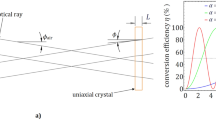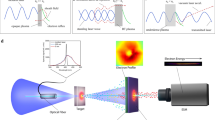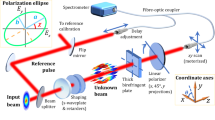Abstract
Recently many ideas have been proposed for the use of a longitudinal field for particle acceleration, fluorescent imaging, second-harmonic generation and Raman spectroscopy. A few methods to enhance the longitudinal field component have been suggested, but all have insufficient optical efficiency and non-uniform axial field strength. Here we report a new method that permits the combination of very unusual properties of light in the focal region, permitting the creation of a ‘pure’ longitudinal light beam with subdiffraction beam size (0.43λ). This beam is non-diffracting; that is, it propagates without divergence over a long distance (of about 4λ) in free space. This is achieved by focusing a radially polarized Bessel–Gaussian beam with a combination of a binary-phase optical element and a high-numerical-aperture lens. This binary optics works as a special polarization filter enhancing the longitudinal component.
This is a preview of subscription content, access via your institution
Access options
Subscribe to this journal
Receive 12 print issues and online access
$209.00 per year
only $17.42 per issue
Buy this article
- Purchase on Springer Link
- Instant access to full article PDF
Prices may be subject to local taxes which are calculated during checkout






Similar content being viewed by others
References
Sheppard, C. J. R. & Saghafi, S. Transverse-electric and transverse-magnetic beam modes beyond the paraxial approximation. Opt. Lett. 24, 1543–1545 (1999).
Dorn, R., Quabis, S. & Leuchs, G. Sharper focus for a radially polarized light beam. Phys. Rev. Lett. 91, 233901 (2003).
Kozawa, Y., Yonezawa, K. & Sato, S. Radially polarized laser beam from a Nd:YAG laser cavity with a c-cut YVO4 crystal. Appl. Phys. B 88, 43–46 (2007).
Richard, B. & Wolf, E. Electromagnetic diffraction in optical systems. II. Structure of the image field in an aplanatic system. Proc. Roy. Soc. A 253, 358–379 (1959).
Cicchitelli, L., Hora, H. & Postle, R. Longitudinal field components for laser beams in vacuum. Phys. Rev. A 41, 3727–3732 (1990).
Sheppard, C. J. R. Electromagnetic field in the focal region of wide-angular annular lens and mirror systems. Microw. Opt. Acoust. 2, 163–166 (1978).
Ganic, D., Gan, X. & Gu, M. Focusing of doughnut laser beams by a high numerical-aperture objective in free space. Opt. Express 11, 2747–2752 (2003).
Lee, K. G. et al. Vector field microscopic imaging of light. Nature Photon. 1, 53–56 (2006).
Fontana, J. R. & Pantell, R. H. A high-energy, laser accelerator for electrons using the inverse Cherenkov effect. J. Appl. Phys. 54, 4285–4288 (1983).
Romea, R. D. & Kimura, W. D. Modelling of inverse Čerenkov laser acceleration with axicon laser-beam focusing. Phys. Rev. D 42, 1807–1818 (1990).
Bouchal, Z. & Olivik, M. Non-diffractive vector Bessel beams. J. Modern Opt. 42, 1555–1566 (1995).
Sheppard, C. J. R. & Török, P. Electromagnetic field in the focal region of an electric dipole wave. Optik 104, 175–177 (1997).
Sun, C.-C. & Liu, C.-K. Ultrasmall focusing spot with a long depth of focus based on polarization and phase modulation. Opt. Lett. 28, 99–101 (2003).
Rosenzweig, J., Murokh, A. & Pellegrini, C. A proposed dielectric-loaded resonant laser accelerator. Phys. Rev. Lett. 74, 2467–2470 (1995).
Novotny, L. et al. Longitudinal field modes probed by single molecules. Phys. Rev. Lett. 86, 5251–5254 (2001).
Bouhelier, A. et al. Near-field second-harmonic generation induced by local field enhancement. Phys. Rev. Lett. 90, 013903 (2003).
Biss, D. P. & Brown, T. G. Polarization-vortex-driven second-harmonic generation. Opt. Lett. 28, 923–925 (2003).
Yew, E. Y. S. & Sheppard, C. J. R. Second harmonic generation polarization microscopy with tightly focused linearly and radially polarized beams. Opt. Commun. 275, 453–457 (2007).
Hayazawa, N., Saito, Y. & Kawata, S. Detection and characterization of longitudinal field for tip-enhanced Raman spectroscopy. Appl. Phys. Lett. 85, 6239–6241 (2004).
Huse, N., Schonle, A. & Hell, S. W. Z-polarized confocal microscopy. J. Biomed. Opt. 6, 480–484 (2001).
Xiao, M. Theoretical treatment for scattering scanning near-field optical microscopy. J. Opt. Soc. Am. A 14, 2977–2984 (1997).
Sheppard, C. J. R. & Choudhury, A. Annular pupils, radial polarization and superresolution. Appl. Opt. 43, 4322–4327 (2004).
Machavariani, G. et al. Efficient extracavity generation of radially and azimuthally polarized beams. Opt. Lett. 32, 1468–1470 (2007).
Sheppard, C. J. R. High-aperture beams. J. Opt. Soc. Am. A 18, 1579–1587 (2001).
Dorn, R., Quabis, S. & Leuchs, G. The focus of light—linear polarization breaks the rotational symmetry of the focal spot. J. Modern Opt. 50, 1917–1926 (2003).
Meyer, M., Romano, V. & Feurer, T. Material processing with pulsed radially and azimuthally polarized laser radiation. Appl. Phys. A 86, 329–334 (2007).
Sheppard, C. J. R. & Wilson, T. Gaussian-beam theory of lenses with annular aperture. Microw. Opt. Acoust. 2, 105–112 (1978).
Youngworth, K. S. & Brown, T. G. Focusing of high numerical aperture cylindrical-vector beams. Opt. Express 7, 77–87 (2000).
Durnin, J., Miceli, J. J. Jr, & Eberly, J. H. Diffraction-free beams. Phys. Rev. Lett. 58, 1499–1501 (1987).
Campos, J. et al. Axially invariant pupil filters. J. Modern Opt. 47, 57–68 (2000).
Li, Y., Lee, H. & Wolf, E. New generalised Bessel–Gaussian beams. J. Opt. Soc. Am. A 21, 640–646 (2004).
Visser, T. D. & Foley, J. T. On the wavefront spacing of focused, radially polarized beams. J. Opt. Soc. Am. A 22, 2527–2531 (2005).
Sheppard, C. J. R. Binary optics and confocal imaging. Opt. Lett. 24, 505–506 (1999).
Wang, H. et al. Subwavelength and super-resolution non-diffraction beam. Appl. Phys. Lett. 89, 171102 (2006).
Sheppard, C. J. R. Synthesis of filters for specified axial properties. J. Modern Opt. 43, 525–536 (1996).
Zhan, Q. Evanescent Bessel beam generation via surface plasmon resonance excitation by a radially polarized beam. Opt. Lett. 31, 1726–1728 (2006).
Luk'yanchuk, B. S. & Ternovsky, V. Light scattering by a thin wire with a surface-plasmon resonance: Bifurcations of the Poynting vector field. Phys. Rev. B 73, 235432 (2006).
Liu, L. et al. Binary-phase spatial filter for real-time swept-source optical coherence microscopy. Opt. Lett. 32, 2375–2377 (2007).
Boivin, A., Dow, J. & Wolf, E. Energy flow in the neighbourhood of the focus of a coherent beam. J. Opt. Soc. Am. 57, 1171–1175 (1967).
Wang, Z. B. et al. Energy flow around a small particle investigated by classical Mie theory. Phys. Rev. B 70, 035418 (2004).
Tribelsky, M. I. & Luk'yanchuk, B. S. Anomalous light scattering by small particles. Phys. Rev. Lett. 97, 263902 (2006).
Lezec, H. J. et al. Beaming light from a subwavelength aperture. Science 297, 820–822 (2002).
Kalosha, V. P. & Golub, I. Toward the subdiffraction focusing limit of optical super-resolution. Opt. Lett. 32, 3540–3542 (2007).
Hao, B. & Leger, J. Experimental measurement of longitudinal component in the vicinity of focused radially polarized beam. Opt. Express 15, 3550–3556 (2007).
Vasnetsov, M. & Staliunas, K. Optical Vortices (Nova Science, Commack, 1999).
Wang, H. & Gan, F. High focal depth with a pure-phase apodizer. Appl. Opt. 40, 5658–5662 (2001).
Wang, H. & Gan, F. Phase-shifting apodizers for increasing focal depth. Appl. Opt. 41, 5263–5266 (2002).
Botcherby, E. J., Juškaitis, R. & Wilson, T. Scanning two photon fluorescence microscopy with extended depth of field. Opt. Commun. 268, 253–260 (2006).
Acknowledgements
The author would like to thank T.D. Visser, S.F. Pereira, J.J.M. Braat and H.P. Urbach for their helpful discussion on radial polarized beam and F. Gan for his helpful discussions on binary optics. The authors would like to acknowledge the LTL project founded by Data Storage Institute.
Author information
Authors and Affiliations
Contributions
The basic idea to achieve subdiffraction and a non-diffracting longitudinal polarized beam was initiated by H.F., C.S. and L.S. were involved in the initial discussion of the idea. All calculations were carried out by H.F. and B.L. C.T.C. helped the planning of the work. The calculation data were analysed and discussed by all of the authors. The paper was drafted by H.F., and all authors contributed to the manuscript.
Corresponding author
Rights and permissions
About this article
Cite this article
Wang, H., Shi, L., Lukyanchuk, B. et al. Creation of a needle of longitudinally polarized light in vacuum using binary optics. Nature Photon 2, 501–505 (2008). https://doi.org/10.1038/nphoton.2008.127
Received:
Accepted:
Published:
Issue Date:
DOI: https://doi.org/10.1038/nphoton.2008.127
This article is cited by
-
Tight focusing Lorenz–Gaussian vortex beams modulated by power order space-variant phase
Optical and Quantum Electronics (2024)
-
Evolution properties of a radially polarized fractional multi-Gaussian Schell-model beam propagating in anisotropic turbulence
Indian Journal of Physics (2024)
-
Focusing characteristics of space-variant quadratic phase modulated linearly polarized Bessel–Gaussian vortex beam
Optical and Quantum Electronics (2024)
-
Achromatic Switchable Liquid-Crystal Twist-q-Plate
Journal of Applied Spectroscopy (2023)
-
Generation of multiple focal pattern via phase modulated radial and azimuthal variant vector beam
Optical and Quantum Electronics (2023)



